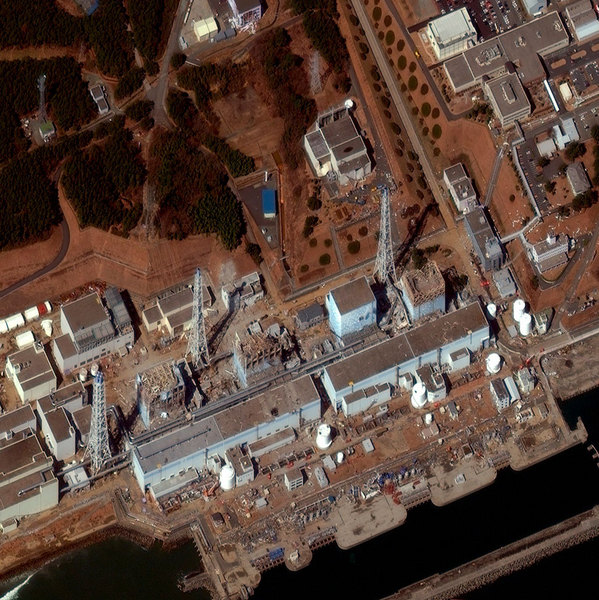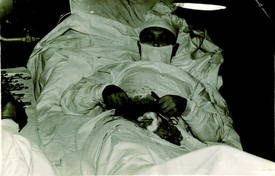Nuclear energy 101: Inside the "black box" of power plants: "

This morning, I got an email from a BoingBoing reader, who is one of the many people worried about the damaged nuclear reactors at Fukushima, Japan. In one sentence, he managed to get right to heart of a big problem lurking behind the headlines today: 'The extent of my knowledge on nuclear power plants is pretty much limited to what I've seen on The Simpsons'.
For the vast majority of people, nuclear power is a black box technology. Radioactive stuff goes in. Electricity (and nuclear waste) comes out. Somewhere in there, we're aware that explosions and meltdowns can happen. Ninety-nine percent of the time, that set of information is enough to get by on. But, then, an emergency like this happens and, suddenly, keeping up-to-date on the news feels like you've walked in on the middle of a movie. Nobody pauses to catch you up on all the stuff you missed.
As I write this, it's still not clear how bad, or how big, the problems at the Fukushima Daiichi power plant will be. I don't know enough to speculate on that. I'm not sure anyone does. But I can give you a clearer picture of what's inside the black box. That way, whatever happens at Fukushima, you'll understand why it's happening, and what it means.
At a basic level, nuclear energy isn't all that different from fossil fuel energy. The process of generating electricity at a nuclear power plant is really all about making heat, just as it is at a coal-fired plant. Heat turns water to steam, steam moves turbines in the electric generator. The only difference is where the heat comes from--to get it, you can light coal on fire, or you can create a controlled nuclear fission reaction.
A fission reaction is a lot like a table filled with Jenga games, each stack of blocks standing close to another stack. Pull out the right block, and one Jenga stack will fall. As it does, it collapses into the surrounding stacks. As those stacks tumble, they crash into others. Nuclear fission works the same way--one unstable atom breaks apart, throwing off pieces of itself, which crash into nearby atoms and cause those to break apart, too.
Every time one of those atoms breaks apart, it releases a little heat. Multiply by millions of atoms, and you have enough heat to turn water into steam*.
In a Boiling Water Reactor, like the ones at Fukushima, water is pumped through the core—the central point where the actual fission reactions happen. Along the way, fission-produced heat boils the water, and the steam rises up and is captured to do the work of turning turbines.
In the Core
The core is the part that really matters today.
In the core of a nuclear reactor, you'll find fuel rods—tubes filled with elements whose atoms are unstable and prone to breaking apart and starting the Jenga-style chain reaction.
Usually, the elements used are Uranium-238 or Uranium-235. They're refined and processed into little black pellets, about the size of your thumbnail, which are poured by the thousands, into long metal tubes. Bunches of tubes--each taller than a basketball player--are grouped together into square frames. These tall, skinny columns are the fuel assemblies.
The fission reactions that happen are all about proximity. In a fuel rod, lots of uranium atoms can crash into each other as they break apart. Pack the fuel rod into an assembly, and lots more atoms can affect one another—which means the reactions can release more energy. Put several fuel assemblies into the core of a nuclear reactor, and the amount of energy released gets even higher.
Proximity is also what makes the difference between a nuclear bomb, and the controlled fission reaction in a power plant. In the bomb, the reactions happen—and the energy is released—very quickly. In the power plant, that process is slowed down by control rods. These work like putting a piece of cardboard between two Jenga towers. The first tower falls, but it hits a barrier instead of the next tower. Of all the atoms that could be split, only a few are allowed to actually do it. And, instead of an explosion, you end up with a manageable amount of heat energy, which can be used to boil water.
In Case of Emergency
Now that you understand what's going on inside a nuclear reactor, you get a good idea of what happened at Fukushima. Like the other nuclear power plants in Japan, Fukushima Daiichi got a message from the country's earthquake warning system, and shut down in advance of the quake. Basically, that means that control rods—"big metal gizmos", as Charles Forsberg, executive director of the MIT Nuclear Fuel Cycle Project, described them to me—were inserted into the fuel assemblies, cutting the fuel rods off from one another. But, because you aren't completely separating all the uranium atoms from one another, shutting down the core isn't the same thing as flipping an 'off' switch.
When a reactor core is shut down, its energy output drops not to zero, but about 6% of its normal output, Forsberg told me. The reactions grind to a halt over the next few days, as the falling Jenga towers run out of other towers they can actually hit. In the meantime, atoms keep breaking apart, releasing both heat and fast-moving particles that can penetrate human skin and damage our cells. Because of this, every nuclear reactor has ways of getting rid of the heat, and blocking those fast-moving radioactive particles.
When the reactor at Fukushima shut down, it should have been kept cool by water pumped through the core. But, because the tsunami damaged the diesel-powered generators that pumped the water, the core kept heating up. If that sounds like a design flaw, you're right. The Fukushima reactors were built in the early 1970s. In modern nuclear reactor designs, pumps aren't necessary to move water through the core in an emergency shut down. Instead, the water moves via gravity.
But, in this case, no pumps meant no water movement. So the core got hotter, which boiled off some of the water. The boiling caused pressure in the core to increase. To protect the core, and prevent a bigger problem, authorities had to vent some of that steam into the atmosphere, which means venting some of the radioactive particles along with them.
This is also probably tied into the explosion that happened, according to MIT's Charles Forsberg.
'There's zirconium in the fuel rods. When you overheat the reactor core, the first thing that happens is that the zirconium begins to react with steam or water and forms zirconium oxide and hydrogen,' he says. 'You get a mixture of steam and hydrogen. When you release steam into a secondary building [to decrease pressure in the core], the steam condenses and leaves behind just the hydrogen. Then all you need is an ignition source and you can get a hydrogen burn. That's what happened at Three Mile Island. I don't know if that's what happened in Japan, but it's likely to be the source of that explosion.'
The good news is that the explosion seems to have happened outside the core. In that case, it's completely reasonable that an explosion could happen without releasing lots of radioactive material. That's because nuclear power plants come in layers, like an onion.
The core is contained within a building that has solid concrete walls, 3-to-6 feet thick. It's meant to withstand collision with an airplane. It's also meant to withstand an explosion from inside. But that bunker sits inside something a lot flimsier—a building more akin to a metal shed. It's the shed that exploded today at Fukushima. Because radiation levels didn't rise after the explosion, we can be pretty certain that the bunker is still intact.
How To Win This
This is a serious emergency, but there are some good reasons to be hopeful. According to World Nuclear News and Reuters, there were seven reactors in Fukushima that were affected by the earthquake. Of those, four have access to outside power to run their water pumps and are stable. Three lost their power. Out of those three, one has steady levels of water. Only two have decreasing water levels. But, in recent hours, workers have started pumping in seawater to one of those. Hopefully, both can be stabilized. But it's hard to say right now.
And then what happens? Remember, this is really just an emergency shutdown gone awry. The control rods are still in place. The Jenga columns are still separated. So, over time, the fission reactions will still slow down and stop. As they do, heat levels will drop, and so will levels of radiation.
Really, what we have here is a waiting game. The goal is to keep the reactors stabilized long enough that the shutdown can completely shut down.
For more information—and details I might have missed—I recommend checking out a recent BBC article, and an interview Skepchick blogger Evelyn did with her father, a nuclear engineer.
*If you want to understand thy physics of nuclear energy in more detail, I'd recommend reading Marcus Chown's The Matchbox That Ate a 40 Ton Truck
Image: Japan Ministry of Land, Infrastructure and Transport. AirPhoto




















